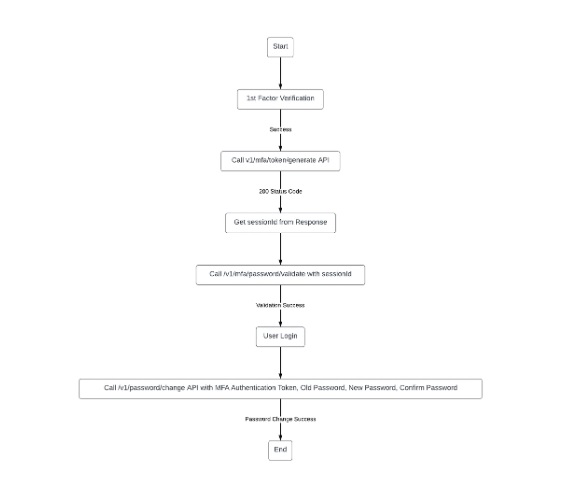post
https://{host}/auth/v1/mfa/password/change
API to change the password.
This API is used to change your password. You need to validate your current password before changing it. The API utilises the token created by /mfa/password/validate, along with the old and new passwords.
The below flow chart shows the steps involved.

API endpoint example
\
Resource information
| URI | auth/v1/mfa/password/change |
| HTTP method | POST |
| Pagination supported? | NA |
| Rate limit | NA |
| Batch support | NA |
Request body parameters
| Parameter
| (Parameters marked with * are mandatory) | Data Type | Description |
|---|---|---|
| deviceId* | String | Unique ID of the device used for password validation. It should be the same device used to generate the MFA token. |
| password* | String | Current password. |
| newPassword* | String | New password. |
| confirmPassword* | String | Re-enter the new password. |
| brand* | String | Name of the brand or organisation that needs verification. |
| token* | String | Token generated from /mfa/password/validate. |
| identifierType* | Enum | The type of identifier to identify the customer. Values: MOBILE, EMAIL, USERNAME, EXTERNALID. |
| identifierValue* | String | The value of the identifier. |
curl --location 'https://crm-nightly-new.ccsolutions.capillarytech.com/auth/v1/password/change' \
--header 'Content-Type: application/json' \
--data '{
"deviceId":"1234",
"password":"12345",
"newPassword":"123456789",
"confirmPassword":"123456789",
"brand":"SOLAPIPOCNEW",
"token":"eyJpZHYiOlsiTU9CSUxFfDc0MTE2MzkyMTMiXSwiZGV2IjoiMTIzNCIsIm9yZyI6IlNPTEFQSVBPQ05FVyIsImFsZyI6IkhTMjU2In0.eyJ1aWQiOiIxMzgiLCJpc3MiOiJDQVBJTExBUlkgVEVDSE5PTE9HSUVTIiwiaXNjIjoiZmFsc2UiLCJvZ2MiOlsiMTQxOHxpbXBvcnQuZGIuMSJdLCJleHAiOjE3MDkxMjU1NDgsImlhdCI6MTcwOTEyMTk0OCwicm9sIjoiTUZBX1BFTkRJTkcifQ.OecVhZmMyXXTkjQBURe3Wi9xruc6gJp2pnd1qv9RGAA",
"identifierType":"MOBILE",
"identifierValue":"7411639213"
}'Response parameters
| Parameter | Datatype | Description |
|---|---|---|
| status | object | Object containing status information. |
| - success | boolean | Boolean indicating the status of the request. |
| - code | integer | HTTP status code indicating the result. Example: 200 indicates success. |
| - message | string | Message describing the status of the request. |
{
"status": {
"success": true,
"code": 200,
"message": "SUCCESS"
}
}